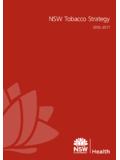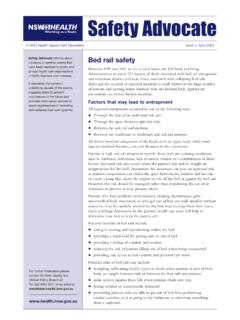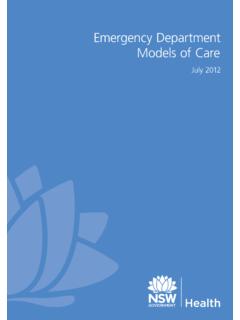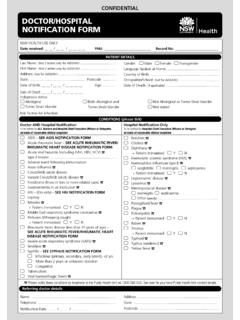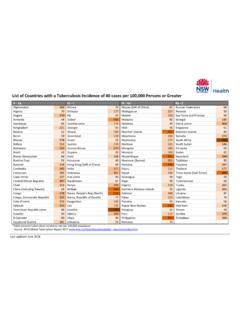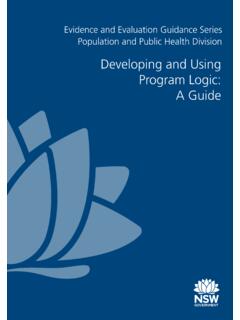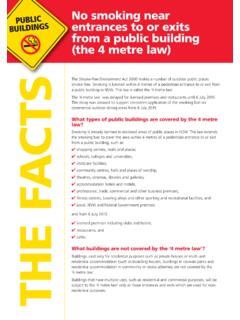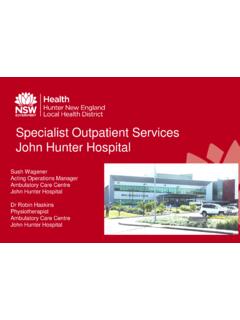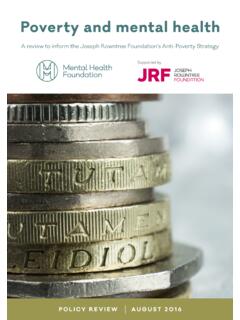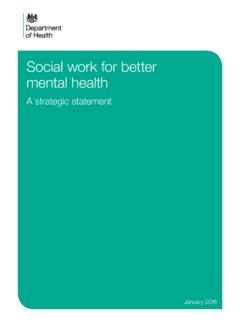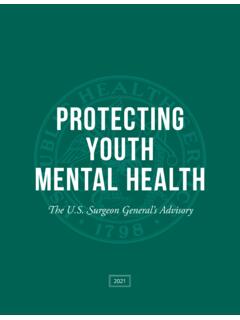Transcription of NSW Aboriginal Mental Health and Wellbeing Strategy 2020 …
1 NSW Aboriginal Mental Health and Wellbeing Strategy2020-2025 AcknowledgementsThe NSW Ministry of Health acknowledges and respects Aboriginal people as the traditional custodians of the lands and waters of NSW and pays respect to Elders past, present and emerging. We acknowledge and thank members of the Aboriginal Mental Health Steering Committee and the Aboriginal Expert Advisory Group who have contributed valuable experience, advice, time and guidance. We acknowledge Aboriginal communities, community organisations, mainstream services and government departments from across NSW for their engagement. A full list of the Aboriginal Mental Health Steering Committee members and those who contributed to the consultations can be found at Appendix would also like to thank the Aboriginal consultancy agency Cox Inall Ridgeway for its expertise in facilitating consultations that helped inform the development of this Strategy .
2 Note that within NSW Health , the term Aboriginal is generally used in preference to Aboriginal and Torres Strait Islander , in recognition that Aboriginal people are the original inhabitants of N Journey: the artworkOur Journey is about coming together and learning off one another. The journey in the painting details the healthy lifestyle choices we make with evident bush tucker and seafood. Also, the blue circles represent the water holes in which we gather, drink and source supply from as well as continue the teaching with our young ones. The big circle in the middle symbolises a meeting place in which all people come together and meet, learn, teach and grow to achieve better results for our families and communities. The symbol on the top right-hand corner represents our ancestor spirits who watches over our journey and helps guide us.* The Connections Aboriginal Women s Art Therapy Group supported Aboriginal women who lived with Mental illness through art therapy and group work.
3 The Connections artists met once a week in a studio in Redfern to paint, yarn and support each other. The group was supported by St Vincent s Hospital with the City of Sydney providing the studio space. Kaylene Simon from St Vincent s Health Australia was the group s coordinator, establishing the group in 2002. Many of the women who attended the group were from all over Australia and the arts and crafts were based on their stories. The Mental Health Branch is authorised to use Our Journey artwork image under licence in Aboriginal Mental Health publications 2017 2026.*The symbol on the top right-hand corner of the artwork represents our ancestor spirits and is indicative of the Kimberley region which may hold cultural sensitivities to the traditional owners of this artwork: Our Journey by Connections Aboriginal Women s Art Therapy group 20172 ContentsA message from the Minister 5 Aboriginal Mental Health and Wellbeing in NSW 6 The social and emotional Wellbeing approach 6 The need for change 8 The policy and service delivery environment 9A new approach for Aboriginal Mental Health and Wellbeing in NSW 10 The Strategy at a glance 11 Who is this Strategy for?
4 12 Shaping the future of Aboriginal Mental Health and Wellbeing in NSW 13 Strengths-based, Aboriginal led co-design 13 Cultural capability and safety 13 Trauma informed holistic healing 14 Supporting and growing the Aboriginal Mental Health workforce 14 Access to quality, coordinated and connected care 15 Co-designed, local implementation 16 Monitoring and reporting 16 Strategic Directions & Actions 17 Goal 1: Holistic, person and family centred care and healing 17 Goal 2: Culturally safe, trauma-informed, quality care 20 Goal 3: Connected care 26 Glossary 31 Acronyms 32 Appendix 1 How was the Strategy developed? 33 Appendix 2 Aboriginal Nations Map 34 References 35 3 NSW Aboriginal Mental Health and Wellbeing Strategy 2020-2025 4I am pleased to introduce the NSW Aboriginal Mental Health and Wellbeing Strategy 2020-2025. This document provides important overarching strategies for action for NSW Health services over the next five years.
5 This Strategy sets the scene for a dramatic shift in the way NSW Health engages with Aboriginal staff, services, consumers, carers, families and message from the Minister Improving the Mental Health and Wellbeing of Aboriginal communities across the state is a priority of the NSW Government. We are committed to ensuring Aboriginal people and families receive the support and attention they need. We respectfully recognise the diverse cultures of Aboriginal people and communities and are determined to work in partnership to make a positive difference in service Strategy will help NSW Health services embed the strategic directions and actions and achieve the goals of holistic, person and family-centred care and healing; culturally safe, trauma-informed, quality care; and connected encourage you to explore the many resources and spotlights available through the document that have been developed in partnership with Aboriginal people and communities throughout NSW.
6 The resources and spotlights are examples of good practice, highlighting strong cultural ways of working and providing holistic care. This document is more than a Strategy ; it is a valuable resource in leading a culturally safe and valuable service in improving the Mental Health and Wellbeing of Aboriginal people, families and communities. The NSW Government is committed to an ongoing monitoring of the implementation process, to ensure NSW Health services are accountable for the ongoing care of Aboriginal people and communities who encounter these services. The Hon. Bronnie Taylor, MLCM inister for Mental Health , Regional Youth and Women 5 NSW Aboriginal Mental Health and Wellbeing Strategy 2020-2025 The social and emotional Wellbeing approachSocial and emotional Wellbeing is widely understood to be the foundation for Aboriginal people s physical, Mental and spiritual social and emotional Wellbeing is a holistic concept that recognises the importance of connection to country, culture, spirituality, ancestry, family and community, and how these affect the This holistic view incorporates the Mental Health and physical, social , emotional, and cultural Wellbeing of individuals and communities and how they each intertwine.
7 The Aboriginal social and emotional Wellbeing model (Figure 1) is a strengths-based approach to working with Mental Health and Wellbeing . It recognises the influence of social , political, historical and cultural factors and can be applied across the continuum of Mental Health connections are disrupted, and for many Aboriginal people and families some of these connections have been significantly disrupted from colonisation, it can lead to ill- Health . The healing and strengthening of these connections will help increase social and emotional Wellbeing for Aboriginal people, families and communities. Promoting strong connections is about maximising the benefits of the protective factors, while minimising exposure to risk factors and particularly those that are also risk factors for Mental Health Historical determinantsSelfPolitical determinantsSocial determinantsConnection to mind & emotionsConnection to bodyConnection to family & kinshipConnection to communityConnection to cultureConnection to countryConnection to spirit, spirituality & ancestors6 Figure 1.
8 A Model of social and Emotional WellbeingAboriginal people belong to a strong living culture that has continued to thrive for thousands of Along with a history of survival, healing and resilience, Aboriginal people have a proud heritage of commitment to family and community, spirituality, and have strong connections to culture and country. Aboriginal people have great strengths, creativity and endurance and a deep understanding of the relationships between human beings and the environment. Aboriginal Mental Health and Wellbeing in NSW As detailed in Table 1, the National Strategic Framework for Aboriginal and Torres Strait Islander Peoples Mental Health and social and Emotional Wellbeing 2017-2023 recognises these and other risk factors, but also provides examples of protective factors that strengthen Mental Health and social and emotional Wellbeing and build Gee, Dudgeon, Schultz, Hart and Kelly, 20136 social and emotional Wellbeing may change over the lifespan of an individual.
9 What is important to a child s social and emotional Wellbeing may be different to an Elder. Aboriginal people s understanding of social and emotional Wellbeing can also vary between different cultural groups and Embracing Aboriginal concepts of social and emotional Wellbeing can assist policy makers, organisations, clinicians and support staff to enable a strengths-based, whole-of-person healing approach within the broader social , cultural and historical context. Table 1: The Domains of social and Emotional Wellbeing with Risk and Protective FactorsDomainDescriptionExamples of risk factorsExamples of protective factorsConnectionto BodyPhysical Health feeling strong and healthy and able to physically participate as fully as possible in life. Chronic and communicable diseases Poor diet Smoking Access to good healthy food Exercise Access to culturally safe, culturally competent and effective Health services and professionalsConnection toMind and EmotionsMental Health - ability to manage thoughts and feelings.
10 Developmental/ cognitive impairments and disability Racism Mental illness Unemployment Trauma including childhood trauma Education Agency: assertiveness, confidence and control over life Strong identityConnection toFamily and KinshipConnections to family and kinship systems are central to the functioning of Aboriginal and Torres Strait Islander societies. Absence of family members Family violence Child neglect and abuse Children in out-of-home care Loving, stable, accepting and supportive family Adequate income Culturally appropriate family focused programs and servicesConnection toCommunityCommunity can take many forms. A connection to community provides opportunities for individuals and families to connect with each other, support each other and work together. Family feuding Lateral violence Lack of local services Isolation Disengagement from community Lack of opportunities for employment in community settings Support networks Community controlled services Self-governanceConnection toCultureA connection to a culture provides a sense of continuity with the past and helps underpin a strong identity.

